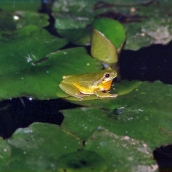Mediterranean Tree Frog (Hyla meridionalis)
This small amphibian generally measures up to 40 mm, but specimens up to 50 mm have been known. The head is short, the snout rounded and the eyes are quite large, with a horizontal pupil. Dorsal colouring is variable, generally dark green and often spotted (in the Canaries and Morocco), but on occasion specimens can be brown or blue and do not turn green. A dark stripe runs part way along the sides, but in juveniles it can reach midway to the flank. This frog shelters in vegetation and is difficult to see, but often gives itself away by its loud call. The distribution area includes the Iberian Peninsula, south of France, northwest Italy, Northwest Africa, the Balearics (Minorca) and the Canaries. Historically, it was introduced in the Canaries, Minorca and Madeira (where it is now extinct) and is found throughout the islands, except for the islets. It occurs in ponds, pools and dams with marginal vegetation, banana plantations (in high density), ravines with near permanent pools, laurisilva laurel forests, evergreen woods and wall-enclosed pastures. Its range ascends to at least 1,550 m. It often shares its habitat with Perez’s frog (Pelophylax perezi), which was also introduced. It feeds mainly on insects (ants, coleopterans, dipterans, etc.), spiders, isopods and arthropods. A few years ago, in a village in La Gomera, several specimens were observed hunting insects (e.g., nocturnal lepidoptera) attracted by the light of the street lamps. It is mostly active at dusk and at night, but at certain times (basically in the breeding season), it is also active by day. On rainy days it can often be seen crossing roads in search of pools in which to breed. It is a climber and is often found off the ground in bushes and trees, sometimes far away from water. It also slips into dried-mud cracks in pools, gaps in stone hedges and animal enclosures. Breeding begins in January or earlier in low-lying areas, and in April or May at higher elevations. Each female can lay between 500 and 1,500 eggs and large quantities of tadpoles in various stages of development are often seen in late spring and summer. Locally abundant in the central and western Canary Islands, particularly in La Gomera and Tenerife (and to a lesser extent in La Palma), it is extremely rare in El Hierro and relegated to a few areas. Curiously, the locality of the Mediterranean tree frog in Tenerife is La Orotava valley, where it was first described by Boettger, in 1874.













